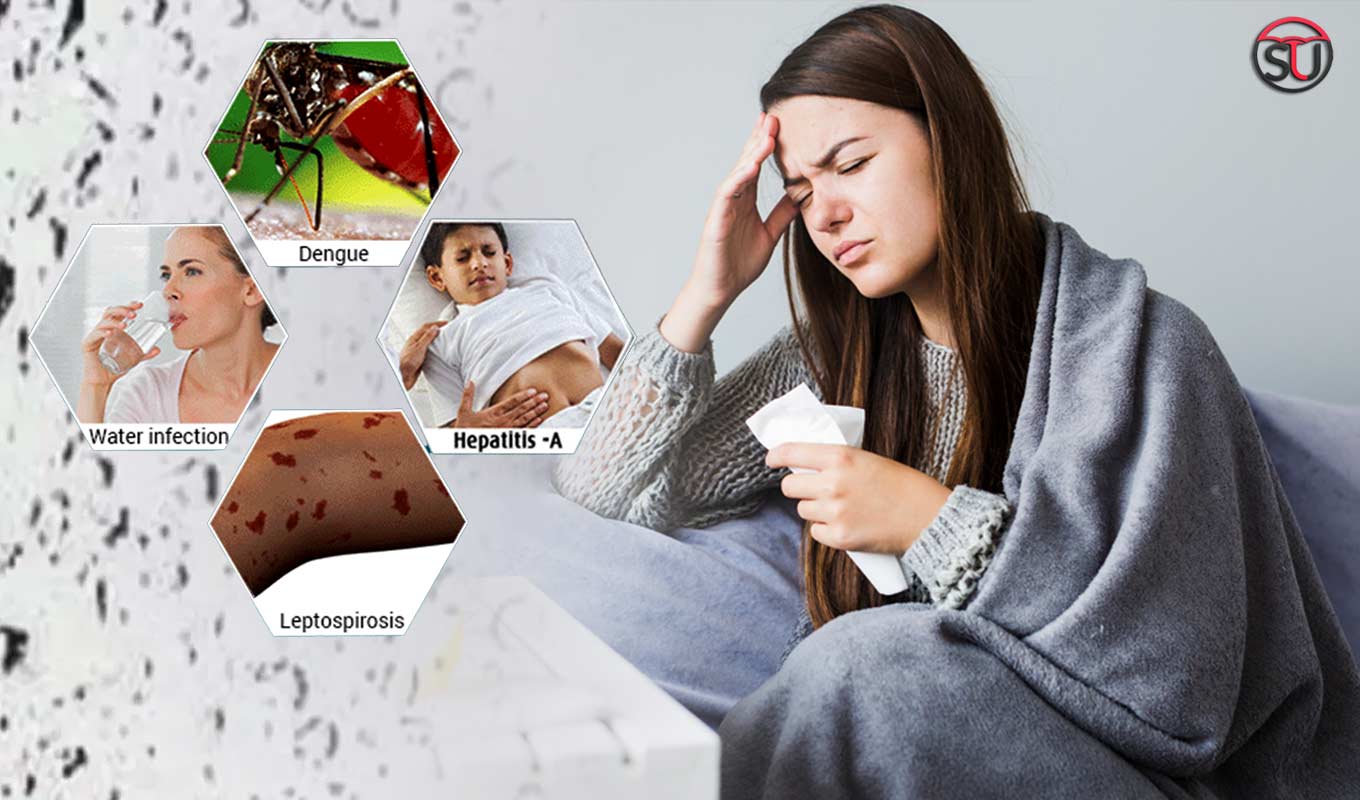Undoubtedly, Monsoon is the best season of the year. After an irritating summer, it offers us a pleasant environment and the refined beauty of nature.
But besides all this, Monsoon also invites a number of deadly diseases such as Dengue, Typhoid, etc. So, you also need to take special care of yourself during this season.
Here, we have mentioned a list of the 5 most common monsoon diseases and how to prevent them.
5 Most Common Monsoon Diseases
1. Dengue

via: Healthline
Dengue is the most common disease during the rainy season. Usually, it spreads through the bites of an Aedes Aegypti mosquito. According to WHO, around 400 million people get infected by this disease every year.
The most dangerous thing about dengue is that you can only recognise its symptoms after 6 to 10 days of getting infected.
Symptoms of Dengue Fever:
- High fever
- Nausea & Vomiting
- Fatigue
- Skin Rashes
- Muscle and joint pain
- Headache
- Eye pain
- Nose bleeding (a very rare condition)
- Restlessness
Prevention techniques: Preventing mosquito bites is the only thing we can do to keep ourselves safe from dengue. You can use mosquito repellents, wear a long-sleeved shirt and close doors and windows to get rid of mosquitos.
2. Malaria

via: Complete Care
Malaria is another major health issue caused by mosquito bites. It spreads by the transmission of parasites to humans through female Anopheles mosquitos. Very high fever is the first symptom of malaria.
According to WHO, nearly 290 million people get infected and more than 4 lakh people die from malaria. So, if you feel any of the symptoms mentioned below, you need to see a doctor as soon as possible.
Symptoms of Malaria:
- Very high fever
- Restlessness
- Headache
- Nausea & Vomiting
- Diarrhoea
- Abdominal pain
- Increased heart rate
- Rapid breathing
- Fatigue
- Cough
- Muscle & joint pain
Prevention techniques: The preventive measures for malaria are the same as dengue because mosquitos cause them both. WHO has also recommended a malaria vaccine for children.
Also Read: Why Vitamin E Capsules are Good for You? See its Benefits, Uses, and Side Effects
3. Skin Infections

via: Hermina Hospitals
The hot and humid weather of the initial monsoon also invites many fungal infections that are bad for your skin. When the humidity in the atmosphere rises, it triggers oil secretion in the body that causes many skin problems like:
- Skin eczema
- Heat rash
- Skin rash
- Itchy skin
- Scabies
- Acen
- Dermatitis
- Pimples
Prevention technique: Avoiding wet clothes is the most important thing to prevent skin infection, especially in monsoon. Apart from that, you can also use some skincare products like antifungal dusting powder, bacterial fighting cleanser, moisturisers, etc.
Also Read: 5 Best Skin Care Tips For Men
4. Typhoid

via: Health Central
Typhoid is one of the most common monsoon diseases. It is caused by salmonella typhi bacteria and is very common in India, especially among children. It develops in the human body through contaminated food and water or close contact with an infected one. Here are some common symptoms.
Symptoms of Typhoid:
- High fever (increasing day by day)
- Weakness and fatigue
- Headache
- Muscle pain
- Dry cough
- Sweating
- Stomach pain
- Weight loss
- Constipation
- Rash
Prevention techniques: Consuming fresh food, drinking pure water and washing your hands regularly are some of the best ways to prevent typhoid. If you are already infected, then a doctor can recommend you some antibiotics.
5. Cholera

via: niddk.nih.gov
Cholera is another bacterial disease which is also caused by contaminated food and water. But its signs and symptoms are totally different from typhoid. It is a very dangerous disease that causes diarrhoea, dehydration, and even death if left untreated.
Symptoms of Cholera:
- Increased heart rate
- Dehydration
- Watery diarrhoea
- Lose skin elasticity
- Low blood pressure
- Muscle cramp
Prevention techniques: The preventive measures for cholera is the same as for typhoid. But if you feel any of these symptoms, you need to take it seriously and visit a doctor as soon as possible. Because this disease can also kill a man in a few hours.



